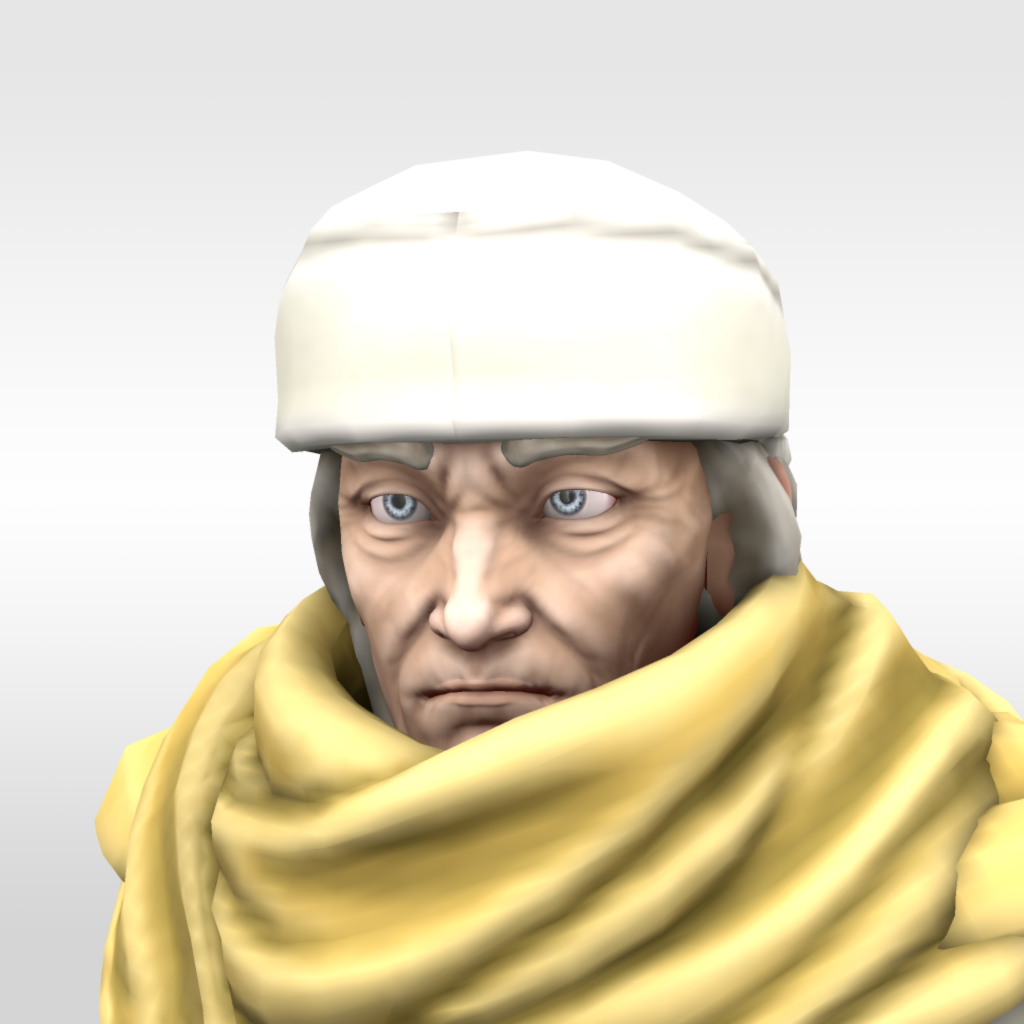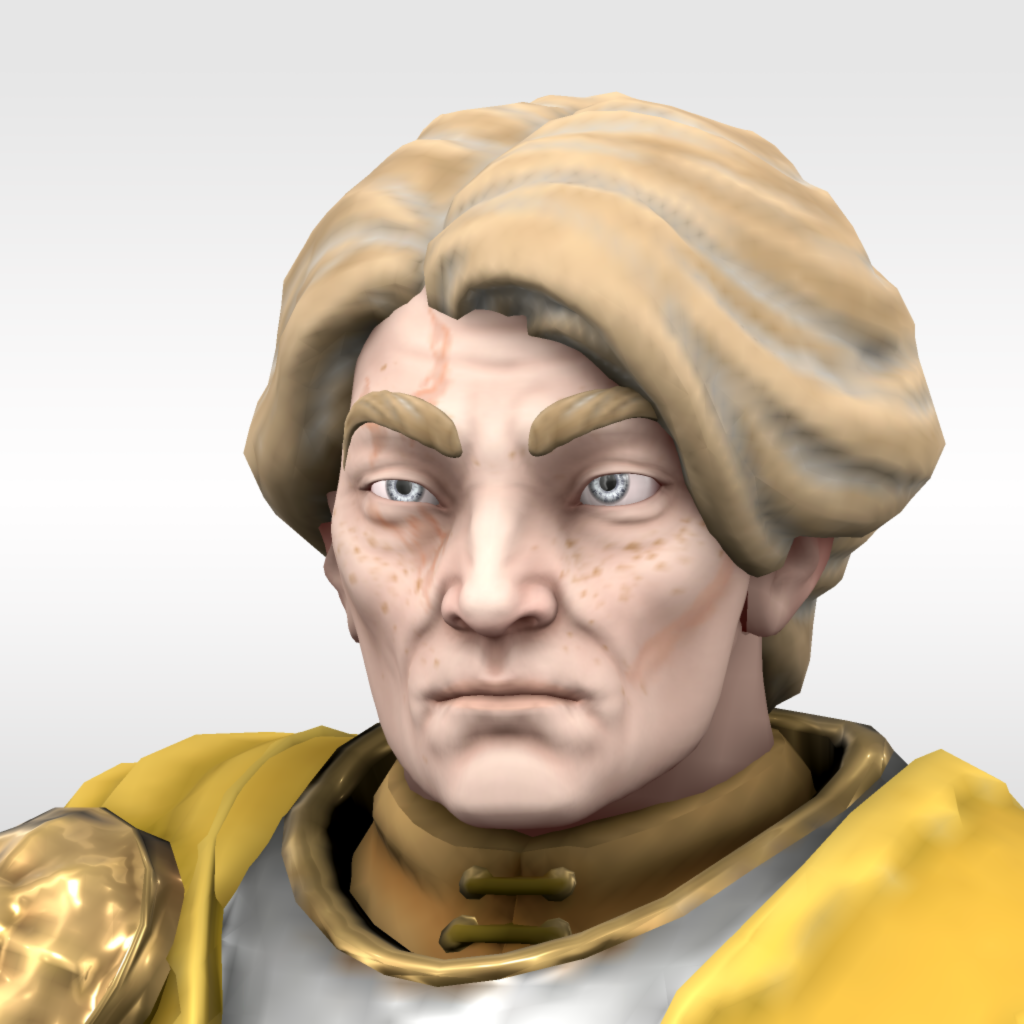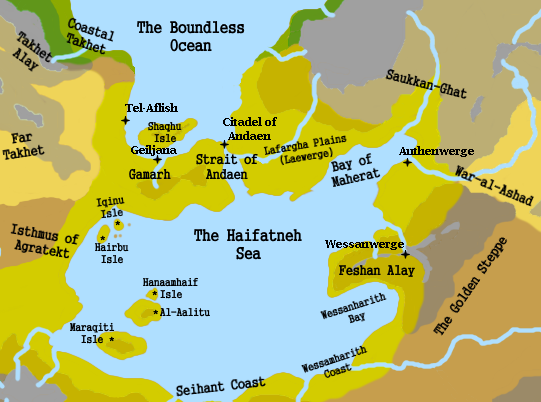The Rae-Matathii in History
By Saffiya an-Winari, historian of the Crusade and Reconquest. 4127 HE.
The following is an overview of the reign and legacy of each Rae-Matath (Highest Interecessor) of the Reborn Theocracy. The Rae-Matathii played an outsized role in the history of Tahuum Itaqiin, being at once heads-of-state and the highest religious authorities in the Bairhanii priesthood. Given their ability to (at least occasionally) appeal to the One Light for miracles that could change the course of a battle or save a community from disaster, as well as their command of the significant personnel and resources of the Reborn Theocracy, it can be argued that the Rae-Matathii were the most powerful (human) individuals of their time.
Each Rae-Matath was known by a single name only, even after the residents of relatively populous Frulthudii settlements began taking on paternal names or other family names. Each Rae-Matath (see below) abandoned his original given name and was given a new one—or, in the case of Teuantius, chosen by the Rae-Matath himself—upon his anointment. This custom was also thought to indicate the Rae-Matath’s singular devotion to religious practice and intercession as opposed to any ties of kinship. Alternatively, the practice may have been adopted in mimicry of the first Rae-Matath Dathfarin, who for reasons lost to history is never attested as having used a second name.
conditions for crops and leading his people’s innovation in horticulture and Medicine, he left matters of external security and politics to those he felt were most competent to address them. It was in this context that the Order of the Returning Sun evolved from a mainly aesthetic holy order into the chief military arm of the Bairhanii priesthood—first in defense of their monasteries, ostensibly, but later in supposedly proactive (pre-emptive) campaigns to “bring the Light” to the Theocracy’s borderlands and beyond, escalating into the particularly brutal purge of Old Agratekt to the Theocracy’s southwest. Rather ironically, the expanding scope of the Theocracy’s military ventures led to militias and the Order requisitioning civilian supplies and labor, at times further compounding the suffering of the Frulthudii settlers and marring Haurfatin’s legacy.
To his credit, Haurfatin is known to have spearheaded several practical reforms in the Theocracy’s development. His skill in horticulture helped adapt imported Frulthudii crops (most impressively cabbages, mustard, and their taxonomical cousins) to their new setting, and through his experimentation with local flora, he developed salves and ointments that relieved the worst symptoms of the novel diseases the colonists encountered. Haurfatin also successfully pushed the Bairhanii priesthood to focus on practical theology, debating and developing guiding ethical principles for believers’ daily struggles and social relations rather than feuding over obscure points of theological contention.
with camel archers which the expedition seemed sure to lose suddenly ended when a fiery, celestial phenomenon, apparently Wiradinus’ doing, drove them back. Whatever it was the camel riders had borne witness to, they reported this circumstance to Chief Jemena en-Mahiin of Tel-Aflish, who then opened his fort’s gates and his arms to the Theocracy’s soldiers. As Chief Jemena had been part of the negotiations to form the nascent anti-Theocracy coalition, their alliance-building effort was derailed, and Wiradinus and his expedition returned to the Theocracy with much fanfare. Word of his apparent miracle in the field preceded him as well.
It is possible that Wiradinus never intended to assume the title of Rae-Matath. But at the time of Haurfatin's sudden decline, there was still no formal process of succession for the title, only a broad agreement that the Rae-Matath should be a suitable representative of the will of the One Light among humanity. Unlike previous and subsequent Rae-Matathii who were mostly selected by the Bairhanii priesthood, Wiradinus was endorsed with enthusiasm by both the Order and a significant portion of the masses. The priesthood, whether fearing mass dissent or simply being unwilling to cast doubt upon the faithfulness of the Order’s membership, relented and anointed Wiradinus.
Wiradinus’ exceptionally successful act of initiative and political defiance seems to have encouraged his already ambitious tendencies. Although the Rae-Matath was typically expected to be a spiritual leader first and foremost, priests based in Andaen would sometimes officiate annual ceremonies in Wiradinus’ stead as he insisted on personally leading campaigns to expand the Theocracy’s holdings well beyond the Gamarh and the northern Haifatneh Basin. That said, his militaristic leanings were paired with political cunning: He established suzerainty across much of coastal Takhet through largely peaceful overtures, and while he tightened the priesthood’s control over most of the Theocracy’s military forces (after the priesthood had been compelled to accept his rule), he continued to permit the Order—by far the most powerful military division in the Theocracy by force of arms and command of divine favor alike—to continue operating autonomously. Thus, Wiradinus consolidated his command over all political and religious spheres of the Theocracy, save for the Order, which already favored him; over the course of his reign, dissidents and populist supporters alike would come to nickname him Fardou Wiradinus, using a regal title from the lost kingdoms of Agratekt.
While the Theocracy’s western campaigns had cowed any opposition there, they had also drawn the ire of the Shadrusun who, by that point in history, otherwise chose to avoid involving themselves in human politics. Internal correspondence of the Order, which was to lead this coming war effort, indicates that this was the true reason for the founding of Citadel of Authenwerge, though the citadel was presented as the latest and most prominent beacon of the One Light. It was also rumored, though perhaps without evidence, that Wiradinus aimed to designate Authenwerge as the Theocracy’s new capital, a move which would’ve exemplified his military-expanionist aims while forsaking Andaen’s status as the premier sacred site of Bairhanii.
The campaign against Hwar-al-Hashad that commenced in 3440 HE remains poorly documented due to the destruction of a great body of Shadrusun archives during that time plus the remarkable casualty rates among the Order’s holy warriors and the Takheti camel-riding mercenaries recruited to fight in the deserts there. It is at least known that Wiradinus’ appearances in Andaen became rare during the first half of that decade, and his sometimes direct involvement in battles there appears to have taken a serious toll on his health. In 3446 HE, while the Order’s operations against Hwar-al-Hashad were ongoing, Wiradinus returned to Andaen, making occasional trips back to Authenwerge but mainly concentrating on domestic statecraft. It is thought that Wiradinus lived for as long as he did in spite of hardships his in early life and wartime because policymaking and planning for the Theocracy’s future kept his mind sharp.
While the destruction of Hwar-al-Hashad may have had the most prominent impact of any initiative during Wiradinus’ reign, the most human misery was caused on other frontiers and borders of the Theocracy. Out of interest in further expanding the Theocracy’s territory (and realizing the primary military forces were strained by the eastward campaigns), Wiradinus preached and wrote of the need for every subject of the Theocracy to “bear the One Light to places yet shrouded in darkness.” Substantiating this decree was Wiradinus’ mobilization of settlers to an unprecedented extent, as he gave orders that existing towns and urban centers set aside resources to supply and arm troupes of frontierspeople who sought to cultivate new lands for themselves. This set of policies led to repeated spates of settler-colonial violence against numerous tribes beyond the Theocracy’s borders, though these settlers were discouraged from carrying out these depredations in Takhet for political reasons. On the domestic front, Wiradinus quelled the dissent of subjugated peoples through a sticks-and-carrots system of religious conversion and cultural re-education.* Opportunities to attain leadership positions were restricted to those subjects practicing Bairhanii, giving locals practical if cynical incentives to convert, and evangelistic campaigns and multilingual religious schools inculcated Bairhanii (and arguably Frulthudii) worldviews in younger generations of the Theocracy’s subjects.
* Bairhanii was long regarded as the sole path to righteousness but, prior to Wiradinus’ new initiative, was generally thought of as the legacy and intangible treasure of the ethnic Frulthudii alone. Further, Wiradinus is known through private correspondence to have felt quite strongly an obligation to ensure the thriving of “his kindred people”—widely understood to be the Frulthudii people. That he sought the cultural assimilation of ethnic minority groups within the Theocracy’s borders indicates a measure of political pragmatism on his part.
* Sometimes attested as Viradinith. It appears that the sound change from ‘w’ to ‘v’ in Kraesprauch, well attested among the Southfold Trekkers, was already under way by this time. As However, Viradinith’s name was often pronounced with a ‘w,’ especially near Andaen and Authenwerge (Authenverge?) where his father spent most of his time. The ending -ith is a diminutive, suggestive of the extent to which Viradinith stood upon his father’s shoulders—or in his shadow. Viradinith is referred to by this alternative rendition of his name from this point forward, so as to spare the reader’s eyes from fatigue for distinguishing between Wiradinus and Wiradinith on parchment.
Viradinith’s domestic and foreign policies followed suit with his father’s with virtually no deviation; this is less likely evidence of sharing his father’s ambition and more suggestive of a lack of initiative on his part. Nor did Viradinith seem to share his father’s eagerness to enter the Theocracy’s battlefronts. Even Authenwerge he only visited twice during his reign—a remarkable contrast from his father, who would sometimes fend off foreign raiding parties on the eastern front himself.
Instead, Viradinith primarily attended to ceremony and domestic affairs in Andaen, though apparently he did not meaningfully innovate in theology or practical matters, either. (Nor is he attested to have performed any miraculous works.) If there is one clear exception, it is that Viradinith was noticeably keen on furthering his father’s policies of religious conversion and (frequently forced) cultural assimilation directed at the non-Frulthudii minority groups within the Theocracy’s borders. In both these policies and his occasional pronouncements against emerging heresies, Viradinith evidently took pains to avoid offending Frulthudii interests, preferring to target second-class or otherwise marginalized subjects for repression. One suspects that his extreme cautiousness in all areas of policymaking save for this one was motivated by a fear of political instability.
As the summer of 3456 HE approached—a mere three years after he was anointed—Viradinith met with the veterans of the Order’s First Vanguard, which had been reduced to a fraction of its former fighting strength during the anti-Shadrusun campaign and hadn’t recovered since. (Recruitment into the Order was a matter of volunteering followed by a trial of faith; presumably, few candidates chose to undergo this initiation once they knew that the Order would sometimes be charged with battling against powerful sorcerors.) This meeting was organized in a discrete fashion, taking place in a campsite unmarked by the Order’s characteristic torch-in-hand insignia. It remains unknown whether Viradinith sought military intelligence or meant to honor (or appease) the Order for their past sacrifices, for the campsite was ambushed by a skirmishing party of riders from Feshan Alay—quite possibly petty raiders who assumed the unmarked camp meant an easy opportunity to extort some hapless travelers.
Hapless indeed, Viradinith was among those who did not survive the ambush. Virdanith’s early demise and his father’s persistent shadow would compound the challenges the next Rae-Matath would face.
The summer after the killing of Viradinith, a retired member of the Order of the Returning Sun, Gunravast of Laewerge, led a more organized campaign promising “no rest, no refuge for the Dawetarti.” The brutality that followed would come to be known to history as the Dawetar Tragedy.
That the violent clearing of former Dawetarti land was celebrated among the Frulthudii frontierspeople was of little assurance to Rae-Matath Hrauwar, for the indigenous peoples who lived within and beyond its borders had already been growing wary of the Theocracy’s territorial ambitions prior to these massacres. The extermination of the Dawetarti people was well known among the pastoralist tribes to the east and southeast, and the outbreak of a conflict with them would test the Theocracy’s forces against highly mobile nomadic warriors, whom they had little experience fighting. In the event that wariness of the Theocracy’s inter-ethnic tensions grew more widespread, this could also threaten their foment hostility among the disparate tribes of Vast Takhet. This would be a more critical security development, as the Theocracy’s hegemony in Near Takhet was key to the fragile peace protecting the Gamarh; the shattering of this peace would leave only Andaen itself and Laewerge as its stable territories. And such a war seemed increasingly likely as Hrauwar’s military advisors demanded greater security on the eastern front.
Dathfarin: A Mythologized Founder Figure
???? - 3423 HE
“His Holiness carried the Light through howling winds and across churning waters. In every lighting of every new beacon, His work is remembered.“Although Dathfarin is widely acknowledged as the spiritual father of Bairhanii, Dathfarin’s true role in the Theocracy’s founding and early history is nonetheless virtually undocumented. This is understandable, as the colonizing Frulthudii are not thought to have brought many documents with them—or else did documents did not survive their voyaging—from their homeland somewhere across the Boundless Ocean. The colonists initially reckoned with new contagions as well as the usual troubles with establishing a new settlement, rendering them largely unable to document the early history in which Dathfarin appears to have fallen ill and died. Even the man’s physical appearance is not well documented, a surprising oversight for a people who are known to have brought artistic traditions with them from overseas. The trouble of these circumstances for historians is not to be underestimated. For one, Dathfarin is widely agreed to have been the most respected teacher of the tenets of Bairhanii, yet any attributions of specific tenets to him can only be taken at face value or discounted as mere folklore. Even the exact amount of time he spent among his people after landfall (or before landfall, for that matter) remains a mystery; the succession of Haurfatin in late 3423 HE indicates that Dathfarin had either passed or was unfit to lead within a year of the landfall at the Haifatneh Strait, but Dathfarin very well could have been bedridden for some or most of this duration, making his spiritual guidance of the Frulthudii colonists indirect at best. Dathfarin and the other colonists appear to have brought with them a dualistic worldview, heavily hierarchical social relations, and a clear gender binary, but on many other issues of concern to the followers of Bairhanii, Dathfarin’s apparent lack of explicit guidance appears to have perpetuated a great many theological and ethical debates. The majority of these have concerned the Bairhanii tenet of “spreading the Light to all dark places”—a common rationale for the Theocracy’s expansionist tendencies—and complex questions of whether a religion introduced to the Continent by the Frulthudii people was meant for that ethnic group alone or for all potential followers. These questions grew increasingly contentious during the reigns of successive Rae-Matathii as the Theocracy came to exercise dominion over a growing range of tribes and cultures.- A standard Bairhanii blessing for the consecration of every new Fire Temple or Beacon.
Haurfatin, the Shepherd through Many Sorrows
3423 - 3434 HE
“His Holiness suffered with his people through sickness and mourned with them through loss. Would that his gentleness were with us for longer.”- Order Inquisitor Bahimad as quoted during the campaign
leading up to the founding of Authenwerge, c. 3434 HE.
Before the Theocracy developed into the expansionist, imperialist power known to history, its founders eked out a harrowing existence as wayward colonists. It was in this context that Haurfatin, Dathfarin’s successor, came to be regarded as his people’s shepherd through their earliest struggles. Among these were the first contagions that ravaged the ranks of the colonists (no doubt as they introduced to the Continent epidemics of their own) and the challenges they faced with adapting their cops and agricultural schedules to the particular climate and environment of the Haifatneh Basin.
Complicating matters for Haurfatin and his flock was their troubled relationship with the predecessors of the Haifatnehti people, from whose lifeways they very well could have learned the solutions to their troubles. Instead, the colonists’ preoccupation with expanding their holdings of farmland—in part because of their struggles to sustain themselves in their new environment—motivated escalating campaigns by the colonists to violently displace local populations from their ancestral lands.
Haurfatin’s disinterest in military affairs seems to have further enabled the settlers’ worst tendencies. While Haurfatin preoccupied himself with supplicating The One Light to bring favorable
Wiradinus, the Campaigner
3434 - 3453 HE
“So it would be with Hwar-al-Hashad as it was with the astrologers from the heights of Saukkan, as it was with the cultists of Agratekt, as it was with the heretics among our own ranks. Wiradinus feared them not but would raise his sword against them, too.”- Excerpt from the epic saga Wiradinus Rebukes the Wicked, c. 3552 HE.
Whereas Haurfatin is known to history chiefly for his works of aid and healing, Wiradinus was the first Rae-Matath to fully embrace the mantle of conqueror.
In the spring of 3434 HE, shortly after the First Vanguard of the Order of the Returning Sun returned from their campaign in Old Agratekt, the Theocracy stumbled into its latest security crisis: Rae-Matath Haurfatin was irrecoverably stricken with an illness—or a curse from vengeful spirits, some suspected. Simultaneously, rumor had it that a coalition of polities from what is now known as Coastal Takhet and camel-herding nomads from the other side of Takhet Alay, alarmed by the Order's violence in Agratekt, were threatening to form an alliance to keep the Theocracy in check.
While those priests close to Haurfatin discussed how they could make peaceful overtures with the peoples of Vast Takhet, an upstart Vigilant of the Order—who would later abandon his birth name and accept the name Wiradinus—clashed with these figureheads in private and then rallied volunteers for a show of force against Tel-Aflish, a stronghold on the border between Takhet and the Theocracy-held plains of the Gamarh. The expedition moved with fierce rapidity—against the Priesthood’s wishes—and a field engagement
With Agratekt and coastal Takhet each subdued in different fashions, Wiradinus turned his ambitions eastward. The Bay of Maherat and the eastern Haifatneh coast, though relatively dry, boasted promising tracts of agricultural land, all the better to feed what Wiradinus understood would be a growing Frulthudii population as their immunity to local diseases and their crops’ adaptivity to their environs both improved. (Rae-Matath Wiradinus, during his rare sermons in Andaen, was fond of characterizing these circumstances instead as his people’s growing “resolve” against disease and the increased “fruitfulness” of the One Light’s blessings.)
Wiradinus’ truest object in expanding the Theocracy’s borders eastward, however, was to establish a new citadel there, not merely to defend these new holdings but in preparation for an impending war with the sorcerous Shadrusun of Hwar-al-Hashad.
Viradinith, the Successor
3453 - 3456 HE
“Be their predecessors saints or tyrants, it is rare that the chosen son or successor can stand steady upon the shoulders of such giants.”- Excerpt from Of Saints and Their Swords, the first of two histories
of the Reborn Theocracy written by Saffiya an-Winari.
Whatever concrete plans Wiradinus had made for his growing empire in the aftermath of the Hwar-al-Hashad campaign can only be inferred from the actions of his successors. Although Wiradinus’ difficult past did not appear to catch up with him as late as 3452 HE (when he was 54 years old), an unidentified health crisis in Mashpalu of 3453 hobbled him, and he suddenly died after a second one a month later.
Apparently, the priesthood lacked concrete guidance for his succession—and far be it for them to in any way offend the One Light's chief representative in Tahuum Itaqiin, even more given the cult of personality in which Wiradinus was feared by most of his subjects and loved by much of the Theocracy's military establishment. Under such an influential figure, it is questionable whether a formal procedure for succession would've been of much use anyway. It seems to have been for this reason that the priesthood selected Wiradinus’ own son, Wiradinith,* as if affirming his aforementioned tongue-in-cheek title of Fardou. The irony here is that while the priesthood is suspected of having made this choice to honor Wiradinus’ wishes, thus avoiding being subject to a purge, there is a growing consensus among historians of this period that Wiradinus, had he not been stricken with health problems that cut his time short, would have selected a senior member of the Order for the title.
Hrauwar, the Beleaguered
3456 - 3475 HE
“Woe, woe, these stars portend naught but woe! What gift can prophecy be, in truth, if one foresees naught but miseries?”- Excerpt from the play Hrauwar, Ever Beleaguered, a piece of historical fiction.
If nothing else, the sudden and irregular demise of Viradinith afforded the priesthood an opportunity to anoint a more obviously qualified member of the clergy as the next Rae-Matath, and through a more orderly process. That said, the sudden leadership vacuum was also cause for considerable anxiety among the Theocracy’s leadership; detractors were increasingly inclined to doubt whether sufficient time and judgment had gone into the selection of Hrauwar, Tastaur of Laewerge (Lafargha), as the Theocracy’s geopolitical situation grew more serious.
Hrauwar’s reign was defined by a troubled past, present, and future alike. Most immediately, the demise of Viradinith within a few days’ ride of Feshan Alay was deemed a sufficient precedent for a retaliatory offensive in the views of the leadership’s military advisors, who were already leery of that insecure border. The settlers who clamored to avenge Viradinith’s killing—and avail themselves to the pasturelands of his alleged murderers—were wholly in agreement. Their expansionist aims proved compatible with the convictions of several influential Tastaurii and Matathii east of Andaen, and it wasn’t long before the Dawetar tribe, the pastoral nomads blamed for the killing of Viradinith, were popularly referred to as “irredeemable tribesmen.” Punitive raids led by volunteer militias of frontierspeople set in motion a cycle of violence.








Goodness what an intriguing document! I love the details you've brought to life; It has mystery, compassion, and political intrigue! You really have created a captivating historical journey! Side note: Also a huge fan of the -ith diminutive and its origin!
Thanks a bunch! I can't wait to finish it up with a few more historical figureheads next month after the WorldEmber awards.